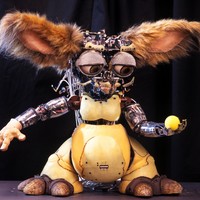
Leonardo
Leonardo was a joint project of the Robotic Life Group at the Media Lab and Stan Winston Studio. At the time he was the most sophisticated expressive humanoid robot in the world, and he may well still be. He has 67 degrees of freedom concealed behind synthetic skin and fur created using advanced techniques originally developed for the film industry.
We designed Leo primarily as a platform for research in human-robot interaction and cooperation, though we also used him as a platform for developing algorithms for machine vision and smooth motion control, sensors for synthetic skin, and so on.
 Developing Leonardo’s motor control system was the largest part of my Masters thesis work while at MIT. The greatest challenge was developing a high-density motor control system to drive the 32 independent motors that make Leonardo’s face and head so uniquely expressive. This was the primary factor that drove the development of my Medusa motor controller line.
Developing Leonardo’s motor control system was the largest part of my Masters thesis work while at MIT. The greatest challenge was developing a high-density motor control system to drive the 32 independent motors that make Leonardo’s face and head so uniquely expressive. This was the primary factor that drove the development of my Medusa motor controller line.
The picture on the left shows Leonardo without his skin. We did much of our early development without the skin, because removing it and installing it again when something goes wrong is quite a bit of work.
In addition to developing the motor control hardware and firmware, I also developed the server-side software that acts essentially as Leo’s cerebellum, as well as the network communications protocol that connects the many computers that comprise Leo’s brain. I also developed many demonstration programs that we used when we presented Leo to visitors during the months and years that his higher-level software was still under development.



